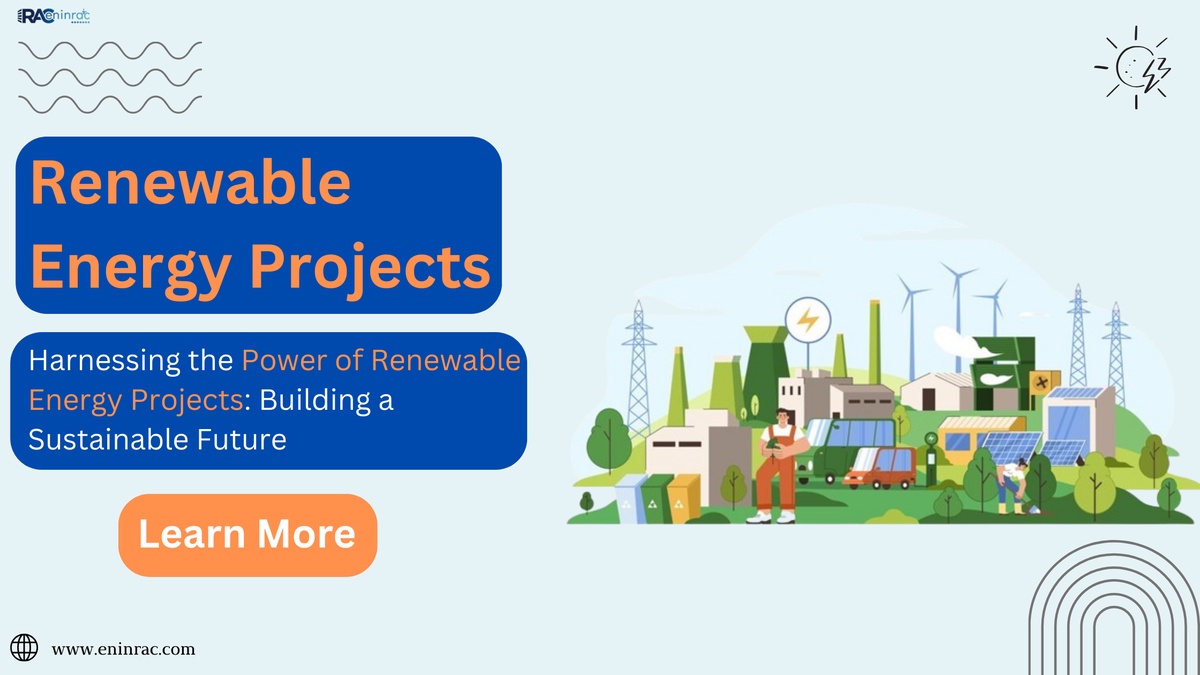In an era defined by climate change and environmental degradation, the urgency to transition towards renewable energy sources has never been more pressing. Renewable energy projects stand as beacons of hope, offering innovative solutions to mitigate the impacts of fossil fuel dependency while paving the way for a sustainable future. From solar farms to wind turbines and hydroelectric plants, these projects hold the key to unlocking a cleaner, greener world. In this blog, we delve into the realm of renewable energy projects, exploring their significance, challenges, and the transformative impact they have on our planet.
Understanding Renewable Energy
Renewable energy refers to energy derived from naturally replenishing sources, such as sunlight, wind, water, and geothermal heat. Unlike finite fossil fuels, renewable energy resources are abundant and environmentally friendly, making them vital components of the global energy transition. Harnessing these resources through various projects is instrumental in reducing greenhouse gas emissions, mitigating climate change, and securing energy independence.
Types of Renewable Energy Projects
Solar Power Projects: Solar energy projects capture sunlight using photovoltaic panels or solar thermal systems, converting it into electricity or heat. From rooftop installations to large-scale solar farms, these projects offer a scalable and versatile solution for clean energy generation.
Wind Energy Projects: Wind turbines harness the kinetic energy of wind to produce electricity. Onshore and offshore wind farms represent significant renewable energy projects, leveraging the power of wind to generate sustainable power for homes, businesses, and communities.
Hydroelectric Projects: Hydroelectric power utilizes the energy of flowing water to generate electricity. Large dams and hydroelectric plants are key examples of these projects, providing reliable and efficient renewable energy while minimizing environmental impact through careful water management.
Biomass Projects: Biomass energy projects utilize organic materials such as wood, agricultural residues, and organic waste to produce heat, electricity, or biofuels. Biomass power plants and biogas facilities contribute to the circular economy by converting waste into valuable energy resources.
Geothermal Projects: Geothermal energy projects harness heat from the Earth’s crust to generate electricity or provide heating and cooling solutions. Geothermal power plants and geothermal heat pumps tap into underground reservoirs of steam and hot water, offering a consistent and sustainable energy source.
Benefits of Renewable Energy Projects
Reduced Carbon Emissions: By displacing fossil fuels, renewable energy projects play a crucial role in reducing carbon dioxide and other greenhouse gas emissions, mitigating the adverse effects of climate change.
Energy Security and Independence: Diversifying the energy mix with renewable sources enhances energy security, reducing reliance on imported fuels and volatile global markets.
Job Creation and Economic Growth: Renewable energy projects stimulate job creation across various sectors, from manufacturing and construction to research and development, fostering economic growth and innovation.
Environmental Preservation: Unlike conventional energy sources, renewable energy projects have minimal environmental impact, preserving ecosystems, conserving water resources, and reducing air and water pollution.
Community Empowerment: Renewable energy projects empower local communities by providing opportunities for investment, job training, and sustainable development, fostering social equity and resilience.
Challenges and Opportunities
While renewable energy projects offer immense potential, they also face certain challenges that must be addressed to realize their full benefits.
Intermittency and Grid Integration: The intermittent nature of renewable energy sources such as solar and wind poses challenges for grid stability and reliability. Innovative solutions such as energy storage, grid modernization, and demand-side management are essential for effective integration.
Resource Variability and Location: The availability and intensity of renewable resources vary geographically, requiring careful planning and site selection for optimal project performance.
Policy and Regulatory Frameworks: Supportive policies, incentives, and regulatory frameworks are critical for driving investment in renewable energy projects and overcoming barriers to deployment.
Technological Innovation: Continued research and development are essential for advancing renewable energy technologies, improving efficiency, reducing costs, and expanding deployment options.
Social Acceptance and Stakeholder Engagement: Building trust and engaging stakeholders are essential for the successful development and implementation of renewable energy projects, addressing concerns related to land use, aesthetics, and community impact.
Conclusion:
Embracing a Sustainable Energy Future Renewable energy projects represent a beacon of hope in the fight against climate change and environmental degradation. From solar and wind to hydroelectric and geothermal, these projects offer scalable, clean, and sustainable solutions to meet our energy needs while preserving the planet for future generations. By overcoming challenges and embracing opportunities, we can accelerate the transition towards a renewable energy future, creating a more resilient, equitable, and prosperous world for all. Let us harness the power of renewable energy projects to build a brighter tomorrow, one powered by the limitless energy of the sun, wind, and water.
More market research, advisory consulting services to discover
At Eninrac, we offer a wide range of, advisory consulting solutions, from We put ‘search’ in research to help expand your business with ease. Discover all the possibilities now.


No comments yet